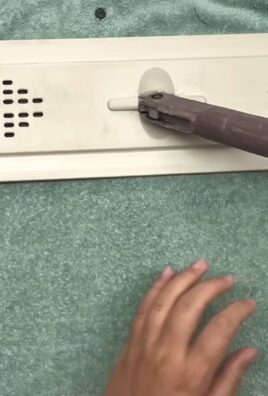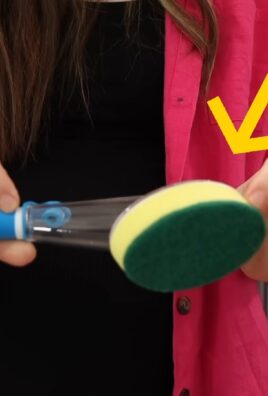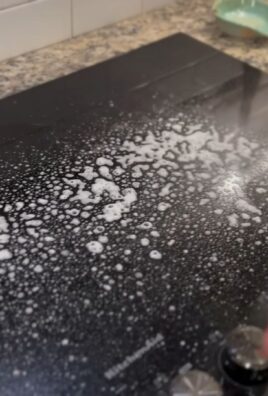Alcohol and Dish Soap Cleaner: Your Secret Weapon for a Sparkling Home!
Are you tired of battling stubborn grime and spending a fortune on commercial cleaners? I know I was! That’s why I’m so excited to share this incredible DIY trick with you. This simple yet powerful alcohol and dish soap cleaner is a game-changer, and it’s about to become your new best friend for tackling everything from greasy stovetops to grimy bathroom tiles.
The concept of using alcohol for cleaning isn’t new. Historically, alcohol has been valued for its disinfectant properties, dating back centuries when it was used to sanitize wounds and surfaces. Combining it with the degreasing power of dish soap creates a synergistic effect, making it a formidable cleaning solution. But why is this DIY cleaner so essential in today’s world? Well, for starters, it’s incredibly cost-effective. You’re likely to have both ingredients already in your home! Plus, it’s a fantastic way to reduce your reliance on harsh chemicals, creating a healthier and more eco-friendly living environment.
This alcohol and dish soap cleaner is not just about saving money and being eco-conscious; it’s about simplifying your life. Imagine having one go-to solution that can handle a multitude of cleaning tasks. No more cluttered cabinets filled with specialized products! Get ready to discover the magic of this simple DIY cleaner and transform your cleaning routine forever.

DIY Streak-Free Window Cleaner: Alcohol and Dish Soap Magic
Okay, so you’re tired of those streaky, smudged windows, right? I totally get it! Store-bought window cleaners can be expensive and often leave behind a frustrating film. That’s why I’m going to share my super simple, super effective DIY window cleaner recipe using just two common household ingredients: rubbing alcohol and dish soap. Trust me, this stuff works wonders!
What You’ll Need
Before we dive in, let’s gather our supplies. This is a pretty minimal list, which is always a win in my book!
* **Rubbing Alcohol (Isopropyl Alcohol):** Aim for 70% or 91% isopropyl alcohol. The higher the percentage, the faster it will evaporate, leaving fewer streaks. I usually grab the 91% for this project.
* **Dish Soap:** A small amount of dish soap helps to cut through grease and grime. Dawn is a popular choice, but any mild dish soap will do. Just avoid anything with added moisturizers or lotions, as those can leave a residue.
* **Spray Bottle:** A clean, empty spray bottle is essential for application. Make sure it’s properly cleaned to avoid contaminating your cleaner.
* **Distilled Water (Optional):** While not strictly necessary, distilled water can help prevent mineral buildup on your windows, especially if you have hard water.
* **Microfiber Cloths:** These are the key to streak-free cleaning! Microfiber cloths are super absorbent and won’t leave lint behind like paper towels can.
* **Bucket (Optional):** If you’re cleaning a lot of windows, a bucket of clean water can be helpful for rinsing your cloths.
* **Squeegee (Optional):** For large windows or glass doors, a squeegee can speed up the process and give you a professional-looking finish.
Mixing the Magic Potion
Now for the fun part – creating our window-cleaning solution!
1. **Prepare Your Spray Bottle:** Make sure your spray bottle is clean and dry. Any residue inside could affect the performance of your cleaner.
2. **Add Rubbing Alcohol:** Pour 1 cup of rubbing alcohol into the spray bottle.
3. **Add Dish Soap:** Add just a *tiny* amount of dish soap – about 1/4 teaspoon. Seriously, a little goes a long way! Too much soap will create suds and leave a residue.
4. **Add Distilled Water (Optional):** If you’re using distilled water, add 1 cup to the spray bottle. If not, just skip this step.
5. **Shake it Up:** Secure the spray bottle lid tightly and shake well to combine all the ingredients.
Cleaning Your Windows: Step-by-Step Guide
Alright, we’ve got our cleaner, we’ve got our supplies, now let’s get those windows sparkling!
1. **Prepare the Area:** Before you start spraying, take a moment to prepare the area around your windows. Move any furniture or decorations that might get in the way. You might also want to lay down a towel or drop cloth to protect your floors from drips.
2. **Dust and Debris Removal:** This is a crucial step! Use a dry microfiber cloth or a brush to remove any loose dust, dirt, or cobwebs from the window surface. If you skip this step, you’ll just be spreading the dirt around when you spray.
3. **Spray the Window:** Hold the spray bottle a few inches away from the window and spray a generous amount of cleaner onto the surface. You want to make sure the entire window is covered, but avoid oversaturating it.
4. **Wipe with a Microfiber Cloth:** Immediately after spraying, use a clean, dry microfiber cloth to wipe the window. Use overlapping strokes and apply gentle pressure to remove dirt and grime.
5. **Dry with a Clean Microfiber Cloth (or Squeegee):** This is where the magic happens! Use a fresh, dry microfiber cloth to buff the window until it’s completely dry and streak-free. If you’re using a squeegee, overlap each stroke slightly and wipe the blade clean after each pass.
6. **Repeat if Necessary:** For particularly dirty windows, you may need to repeat the spraying and wiping process. Don’t be afraid to give it a second go!
7. **Clean Your Cloths:** As you clean, your microfiber cloths will become dirty. Keep a bucket of clean water nearby to rinse them out. Wring them out thoroughly before continuing to wipe. You can also switch to a fresh cloth as needed.
Tips and Tricks for Sparkling Results
Here are a few extra tips to help you achieve the best possible results:
* **Choose the Right Time of Day:** Avoid cleaning your windows in direct sunlight, as the cleaner will dry too quickly and leave streaks. Overcast days are ideal.
* **Clean from Top to Bottom:** This will prevent drips from running down onto already-cleaned areas.
* **Don’t Forget the Edges:** Pay attention to the edges and corners of your windows, as these areas tend to accumulate dirt and grime.
* **Wash Your Microfiber Cloths Regularly:** Dirty cloths will only spread dirt around. Wash your microfiber cloths in the washing machine with a mild detergent and avoid using fabric softener, as it can reduce their absorbency.
* **Test in an Inconspicuous Area:** Before cleaning an entire window, test the cleaner in a small, inconspicuous area to make sure it doesn’t damage the surface. This is especially important for tinted windows or windows with special coatings.
* **For Stubborn Stains:** For stubborn stains like bird droppings or tree sap, try letting the cleaner sit on the stain for a few minutes before wiping it away. You can also use a plastic scraper to gently remove the stain.
* **Clean Your Window Screens:** Dirty window screens can make your windows look dirty, even after you’ve cleaned them. Remove your screens and wash them with soap and water before replacing them.
* Consider a Magic Eraser: For really tough spots, a slightly damp magic eraser can work wonders. Just be gentle and test in an inconspicuous area first.
Troubleshooting Common Problems
Even with the best recipe and technique, you might encounter a few challenges. Here’s how to troubleshoot some common problems:
* **Streaks:** If you’re getting streaks, it could be due to several factors:
* **Too much dish soap:** Reduce the amount of dish soap in your cleaner.
* **Dirty cloths:** Use clean, dry microfiber cloths.
* **Direct sunlight:** Clean your windows on an overcast day.
* **Hard water:** Use distilled water in your cleaner.
* **Residue:** If you’re noticing a residue on your windows, it could be due to:
* **Too much dish soap:** Reduce the amount of dish soap in your cleaner.
* **Dish soap with added moisturizers:** Use a plain, mild dish soap.
* **Hard water:** Use distilled water in your cleaner.
* **Smudges:** If you’re seeing smudges, it could be due to:
* **Not removing dust and debris:** Make sure to remove loose dirt and dust before spraying.
* **Dirty cloths:** Use clean, dry microfiber cloths.
Cleaning Different Types of Glass
This DIY window cleaner is generally safe for most types of glass, but here are a few things to keep in mind for specific surfaces:
* **Tinted Windows:** Test the cleaner in an inconspicuous area before cleaning the entire window. Avoid using abrasive cleaners or scrub brushes, as they can damage the tint.
* **Mirrors:** This cleaner works great on mirrors! Just be careful not to get any cleaner on the frame, as it could damage the finish.
* **Shower Doors:** This cleaner can also be used to clean shower doors, but you may need to use a scrub brush to remove soap scum and hard water stains.
* **Car Windows:** This cleaner is safe to use on car windows, but avoid getting any cleaner on the car’s paint, as it could damage the finish.
Safety First!
While this DIY window cleaner is relatively safe, it’s always a good idea to take a few precautions:
* **Ventilation:** Work in a well-ventilated area to avoid inhaling the fumes from the rubbing alcohol.
* **Eye Protection:** Wear safety glasses or goggles to protect your eyes from splashes.
* **Skin Protection:** Wear gloves to protect your skin from irritation.
* **Keep Out of Reach of Children and Pets:** Store the cleaner in a safe place where children and pets cannot access it.
* **Don’t Mix with Other Cleaners:** Never mix this cleaner with other cleaning products, as this could create dangerous fumes.
Storage
Store your DIY window cleaner in a cool, dark place away from direct sunlight and heat. The cleaner should last for several months. Be sure to label the spray bottle clearly so you don’t accidentally use it for something else!
So, there you have it! My go-to recipe for sparkling, streak-free windows. Give it a

Conclusion
So, there you have it! This simple yet incredibly effective Alcohol and Dish Soap Cleaner is a game-changer for anyone looking to achieve sparkling surfaces without harsh chemicals or breaking the bank. We’ve walked you through the easy steps to create this powerful cleaning solution, and now it’s time to experience the difference for yourself.
Why is this DIY cleaner a must-try? Because it’s a trifecta of awesome: it’s cost-effective, environmentally friendly, and remarkably efficient. Commercial cleaners often come with a hefty price tag and a list of ingredients that read like a chemistry textbook. This homemade version uses just two readily available ingredients – rubbing alcohol and dish soap – making it a budget-friendly alternative. Plus, you’re reducing your reliance on plastic bottles and potentially harmful chemicals that can pollute our environment.
But the real magic lies in its cleaning power. The alcohol acts as a disinfectant, killing germs and bacteria, while the dish soap cuts through grease and grime, leaving surfaces spotless and streak-free. It’s a winning combination that tackles everything from kitchen countertops and bathroom tiles to glass surfaces and stainless steel appliances.
Looking to customize your cleaner? Consider these variations:
* Essential Oil Boost: Add a few drops of your favorite essential oil, such as lemon, lavender, or tea tree, for a pleasant scent and added antibacterial properties. Just be sure to use oils that are safe for the surfaces you’re cleaning.
* Vinegar Power-Up: For extra cleaning oomph, especially on stubborn stains, add a tablespoon of white vinegar to the mix. Vinegar is a natural disinfectant and degreaser. However, avoid using vinegar on natural stone surfaces like marble or granite.
* Water Adjustment: Depending on the strength of your dish soap and the type of surfaces you’re cleaning, you may need to adjust the amount of water in the solution. Start with the recommended ratio and experiment to find what works best for you.
We’re confident that once you try this Alcohol and Dish Soap Cleaner, you’ll be hooked. It’s a simple, effective, and eco-friendly way to keep your home sparkling clean. Don’t just take our word for it – give it a try and see the results for yourself!
We encourage you to experiment with different variations and find what works best for your needs. And most importantly, we want to hear about your experience! Share your tips, tricks, and before-and-after photos in the comments below. Let’s build a community of DIY cleaning enthusiasts and help each other create a cleaner, healthier home.
Now, let’s address some frequently asked questions to ensure you have all the information you need to get started.
Frequently Asked Questions
Is this cleaner safe to use on all surfaces?
While the Alcohol and Dish Soap Cleaner is generally safe for most surfaces, it’s always a good idea to test it in an inconspicuous area first, especially on delicate or sensitive materials. Avoid using it on natural stone surfaces like marble or granite, as the alcohol or vinegar (if added) can etch or damage the stone. Also, be cautious when using it on painted surfaces, as it may dull the finish over time. Always dilute the solution properly and avoid prolonged contact with any surface. If you are unsure, consult the manufacturer’s instructions for the surface you intend to clean.
What type of alcohol should I use?
Isopropyl alcohol, also known as rubbing alcohol, is the recommended type for this cleaner. Look for a concentration of 70% or higher for optimal disinfecting power. You can typically find rubbing alcohol at your local pharmacy or grocery store. Avoid using denatured alcohol or other types of alcohol that may contain additives that could damage surfaces or be harmful to your health.
Can I use any type of dish soap?
While most dish soaps will work, it’s best to use a mild, non-abrasive dish soap. Avoid using dish soaps that contain bleach or other harsh chemicals, as these can react with the alcohol and create harmful fumes. A clear, unscented dish soap is often a good choice, as it’s less likely to leave behind residue or streaks.
How long will the cleaner last?
The Alcohol and Dish Soap Cleaner can be stored for several weeks in an airtight container. However, it’s best to use it within a few weeks for optimal effectiveness. Over time, the alcohol may evaporate, reducing the cleaning power of the solution. Store the cleaner in a cool, dark place to prolong its shelf life.
Can I use this cleaner to disinfect surfaces?
Yes, the alcohol in this cleaner acts as a disinfectant, killing germs and bacteria on surfaces. However, it’s important to note that this cleaner is not a substitute for hospital-grade disinfectants. For thorough disinfection, especially in areas with high risk of contamination, it’s best to use a commercially available disinfectant that is specifically designed for that purpose. When using this cleaner for disinfecting, allow it to sit on the surface for a few minutes before wiping it away to allow the alcohol to kill germs effectively.
Is this cleaner safe to use around children and pets?
While the ingredients in this cleaner are generally considered safe, it’s important to keep it out of reach of children and pets. Alcohol can be harmful if ingested, and dish soap can cause irritation. Store the cleaner in a secure location and label it clearly to prevent accidental ingestion. When using the cleaner, ensure that the area is well-ventilated and avoid spraying it directly into the eyes or mouth. If you have any concerns about the safety of this cleaner around children or pets, consult with a healthcare professional or veterinarian.
Can I use this cleaner on electronics?
It’s generally not recommended to use this cleaner on electronics, as the alcohol can damage sensitive components. Instead, use a microfiber cloth dampened with distilled water to clean electronic screens and surfaces. If you need to disinfect electronics, use a commercially available electronic cleaner that is specifically designed for that purpose. Always unplug electronics before cleaning them and avoid getting any liquid inside the device.
What if the cleaner leaves streaks?
If the Alcohol and Dish Soap Cleaner leaves streaks, it could be due to several factors, such as using too much dish soap, not diluting the solution properly, or using a dirty cloth. Try reducing the amount of dish soap in the solution or diluting it further with water. Also, make sure to use a clean, lint-free microfiber cloth to wipe the surfaces. You may also need to buff the surface with a dry cloth after wiping it down to remove any remaining residue.
Can I use this cleaner to clean my car interior?
This cleaner can be used to clean some parts of your car interior, such as the dashboard and door panels. However, avoid using it on leather or suede surfaces, as the alcohol can dry them out and cause damage. Also, be cautious when using it on plastic surfaces, as it may dull the finish over time. Always test the cleaner in an inconspicuous area first and avoid prolonged contact with any surface. For cleaning car upholstery, it’s best to use a specialized car upholstery cleaner.




Leave a Comment